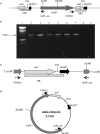Comparative analysis of sequences flanking tet(W) resistance genes in multiple species of gut bacteria
- PMID: 16870752
- PMCID: PMC1538676
- DOI: 10.1128/AAC.01587-05
Comparative analysis of sequences flanking tet(W) resistance genes in multiple species of gut bacteria
Abstract
tet(W) is one of the most abundant tetracycline resistance genes found in bacteria from the mammalian gut and was first identified in the rumen anaerobe Butyrivibrio fibrisolvens 1.230, where it is highly mobile and its transfer is associated with the transposable chromosomal element TnB1230. In order to compare the genetic basis for tet(W) carriage in different bacteria, we studied sequences flanking tet(W) in representatives of seven bacterial genera originating in diverse gut environments. The sequences 657 bp upstream and 43 bp downstream of tet(W) were 96 to 100% similar in all strains examined. A common open reading frame (ORF) was identified downstream of tet(W) in five different bacteria, while another conserved ORF that flanked tet(W) in B. fibrisolvens 1.230 was also present upstream of tet(W) in a human colonic Roseburia isolate and in another rumen B. fibrisolvens isolate. In one species, Bifidobacterium longum (strain F8), a novel transposase was located within the conserved 657-bp region upstream of tet(W) and was flanked by imperfect direct repeats. Additional direct repeats 6 bp long were identified on each end of a chromosomal ORF interrupted by the insertion of the putative transposase and the tet(W) gene. This tet(W) gene was transferable at low frequencies between Bifidobacterium strains. A putative minielement carrying a copy of tet(W) was identified in B. fibrisolvens transconjugants that had acquired the tet(W) gene on TnB1230. Several different mechanisms, including mechanisms involving plasmids and conjugative transposons, appear to be involved in the horizontal transfer of tet(W) genes, but small core regions that may function as minielements are conserved.
Figures





Similar articles
-
The Butyrivibrio fibrisolvens tet(W) gene is carried on the novel conjugative transposon TnB1230, which contains duplicated nitroreductase coding sequences.J Bacteriol. 2004 Jun;186(11):3656-9. doi: 10.1128/JB.186.11.3656-3659.2004. J Bacteriol. 2004. PMID: 15150255 Free PMC article.
-
Analysis of tetracycline resistance tet(W) genes and their flanking sequences in intestinal Bifidobacterium species.J Antimicrob Chemother. 2008 Oct;62(4):688-93. doi: 10.1093/jac/dkn280. Epub 2008 Jul 8. J Antimicrob Chemother. 2008. PMID: 18614524
-
Evidence for recent intergeneric transfer of a new tetracycline resistance gene, tet(W), isolated from Butyrivibrio fibrisolvens, and the occurrence of tet(O) in ruminal bacteria.Environ Microbiol. 1999 Feb;1(1):53-64. doi: 10.1046/j.1462-2920.1999.00004.x. Environ Microbiol. 1999. PMID: 11207718
-
Update on acquired tetracycline resistance genes.FEMS Microbiol Lett. 2005 Apr 15;245(2):195-203. doi: 10.1016/j.femsle.2005.02.034. FEMS Microbiol Lett. 2005. PMID: 15837373 Review.
-
Conjugative transposition.Annu Rev Microbiol. 1995;49:367-97. doi: 10.1146/annurev.mi.49.100195.002055. Annu Rev Microbiol. 1995. PMID: 8561465 Review.
Cited by
-
Bifidobacterium adolescentis is intrinsically resistant to antitubercular drugs.Sci Rep. 2018 Aug 9;8(1):11897. doi: 10.1038/s41598-018-30429-2. Sci Rep. 2018. PMID: 30093677 Free PMC article.
-
A new tetracycline efflux gene, tet(40), is located in tandem with tet(O/32/O) in a human gut firmicute bacterium and in metagenomic library clones.Antimicrob Agents Chemother. 2008 Nov;52(11):4001-9. doi: 10.1128/AAC.00308-08. Epub 2008 Sep 8. Antimicrob Agents Chemother. 2008. PMID: 18779355 Free PMC article.
-
Perspectives in the use of tannins as alternative to antimicrobial growth promoter factors in poultry.Front Microbiol. 2014 Mar 27;5:118. doi: 10.3389/fmicb.2014.00118. eCollection 2014. Front Microbiol. 2014. PMID: 24723916 Free PMC article. Review.
-
Tetracycline resistome of the organic pig gut.Appl Environ Microbiol. 2009 Mar;75(6):1717-22. doi: 10.1128/AEM.02206-08. Epub 2009 Jan 23. Appl Environ Microbiol. 2009. PMID: 19168656 Free PMC article.
-
Determination of the genetic support for tet(W) in oral bacteria.Antimicrob Agents Chemother. 2007 Jun;51(6):2195-7. doi: 10.1128/AAC.01587-06. Epub 2007 Mar 19. Antimicrob Agents Chemother. 2007. PMID: 17371816 Free PMC article.
References
-
- Barbosa, T. M. 1998. Tetracycline resistance transfer among obligate anaerobes from the ruminant gut. PhD thesis. University of Aberdeen, Aberdeen, United Kingdom.
-
- Barbosa, T. M., K. P. Scott, and H. J. Flint. 1999. Evidence for recent intergeneric transfer of a new tetracycline resistance gene, tet(W), isolated from Butyrivibrio fibrisolvens, and the occurence of tet(O) in ruminal bacterial. Environ. Microbiol. 1:53-64. - PubMed
Publication types
MeSH terms
Substances
LinkOut - more resources
Full Text Sources
Miscellaneous

